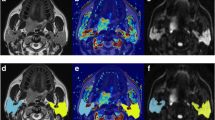Abstract
We aimed to quantitatively investigate the alteration of parotid perfusion after irradiation using dynamic contrast-enhanced magnetic resonance imaging (DCE-MRI) based on a two-compartment tracer kinetic model. This study enrolled 19 patients (53.2 ± 14.9 years) treated by head and neck radiotherapy and 19 age-relevant and sex-matched subjects as a control group. Perfusion parameters (K el , k 21 and A) of parotid glands were analyzed based on the Brix model from T1-weighted DCE-MRI. Suitability of the Brix model was evaluated via Monte Carlo simulation for the goodness-of-fit. Analysis of nonlinear goodness-of-fit showed that the Brix model is appropriate in evaluating the parotid perfusion (R2 = 0.938 ± 0.050). The irradiated parotid glands showed significantly lower K el (P < 0.0005) and k 21 (P < 0.05) and consequently significantly higher value of peak enhancement (P < 0.0005) and time-to-peak (P < 0.0005) compared with non-irradiated ones, suggestive of gradual and prolonged accumulation and delayed wash-out of contrast agent due to increased extracellular extravascular space and decreased vascular permeability in the irradiated glands. Linear regression analysis showed dose-dependent perfusion changes of the irradiated parotid glands. We conclude that quantitative DCE-MRI is a potential tool in investigating parotid gland perfusion changes after radiotherapy.



Similar content being viewed by others
References
Cairncross JG, Salmon J, Kim JH, Posner JB (1980) Acute parotitis and hyperamylasemia following whole-brain radiation therapy. Ann Neurol 7:385–387
de Castro GJ, Federico MH (2006) Evaluation, prevention and management of radiotherapy-induced xerostomia in head and neck cancer patients. Curr Opin Oncol 18:266–270
Jen YM, Lin YC, Wang YB, Wu DM (2006) Dramatic and prolonged decrease of whole salivary secretion in nasopharyngeal carcinoma patients treated with radiotherapy. Oral Surg Oral Med Oral Pathol Oral Radiol Endod 101:322–327
Li J, Shan Z, Ou G et al (2005) Structural and functional characteristics of irradiation damage to parotid glands in the miniature pig. Int J Radiat Oncol Biol Phys 62:1510–1516
Stephens L, King G, Peters L, Ang K, Schultheiss T, Jardine J (1986) Acute and late radiation injury in rhesus monkey parotid glands. Evidence of interphase cell death. Am J Pathol 124:469–478
Henriksson R, Frojd O, Gustafsson H et al (1994) Increase in mast cells and hyaluronic acid correlates to radiation-induced damage and loss of serous acinar cells in salivary glands: the parotid and submandibular glands differ in radiation sensitivity. Br J Cancer 69:320–326
Lotz S, Caselitz J, Tschakert H, Rehpenning W, Seifert G (1990) Radioprotection of minipig salivary glands by orciprenaline-carbachol. An ultrastructural and semiquantitative light microscopic study. Virchows Arch A Pathol Anat Histopathol 417:119–128
Cox JD, Stetz J, Pajak TF (1995) Toxicity criteria of the Radiation Therapy Oncology Group (RTOG) and the European Organization for Research and Treatment of Cancer (EORTC). Int J Radiat Oncol Biol Phys 31:1341–1346
Kohler PF, Winter ME (1985) A quantitative test for xerostomia. The Saxon test, an oral equivalent of the Schirmer test. Arthritis Rheum 28:1128–1132
Shah GV (2004) MR imaging of salivary glands. Neuroimaging Clin N Am 14:777–808
Tartaglino LM, Rao VM, Markiewicz DA (1994) Imaging of radiation changes in the head and neck. Semin Roentgenol 29:81–91
Bronstein AD, Nyberg DA, Schwartz AN, Shuman WP, Griffin BR (1987) Increased salivary gland density on contrast-enhanced CT after head and neck radiation. AJR Am J Roentgenol 149:1259–1263
Rabin BM, Meyer JR, Berlin JW, Marymount MH, Palka PS, Russell EJ (1996) Radiation-induced changes in the central nervous system and head and neck. Radiographics 16:1055–1072
Nomayr A, Lell M, Sweeney R, Bautz W, Lukas P (2001) MRI appearance of radiation-induced changes of normal cervical tissues. Eur Radiol 11:1807–1817
Yabuuchi H, Fukuya T, Tajima T, Hachitanda Y, Tomita K, Koga M (2003) Salivary gland tumors: diagnostic value of gadolinium-enhanced dynamic MR imaging with histopathologic correlation. Radiology 226:345–354
Buckley DL, Kerslake RW, Blackband SJ, Horsman A (1994) Quantitative analysis of multi-slice Gd-DTPA enhanced dynamic MR images using an automated simplex minimization procedure. Magn Reson Med 32:646–651
Larsson HB, Stubgaard M, Frederiksen JL, Jensen M, Henriksen O, Paulson OB (1990) Quantitation of blood-brain barrier defect by magnetic resonance imaging and gadolinium-DTPA in patients with multiple sclerosis and brain tumors. Magn Reson Med 16:117–131
Ikeda M, Motoori K, Hanazawa T et al (2004) Warthin tumor of the parotid gland: diagnostic value of MR imaging with histopathologic correlation. AJNR Am J Neuroradiol 25:1256–1262
Brix G, Semmler W, Port R, Schad LR, Layer G, Lorenz WJ (1991) Pharmacokinetic parameters in CNS Gd-DTPA enhanced MR imaging. J Comput Assist Tomogr 15:621–628
Bates D, Watts D (1988) Nonlinear regression analysis and its applications: Wiley:33–66
Munter MW, Karger CP, Hoffner SG et al (2004) Evaluation of salivary gland function after treatment of head-and-neck tumors with intensity-modulated radiotherapy by quantitative pertechnetate scintigraphy. Int J Radiat Oncol Biol Phys 58:175–184
Buus S, Grau C, Munk OL, Bender D, Jensen K, Keiding S (2004) 11C-methionine PET, a novel method for measuring regional salivary gland function after radiotherapy of head and neck cancer. Radiother Oncol 73:289–296
Gustafsson H, Franzen L, Henriksson R (1995) Regeneration of parotid acinar cells after high radiation doses. A morphological study in rat. Acta Oncol 34:193–197
Radfar L, Sirois D (2003) Structural and functional injury in minipig salivary glands following fractionated exposure to 70 Gy of ionizing radiation an animal model for human radiation-induced salivary gland injury. Oral Surg Oral Med Oral Pathol Oral Radiol Endod 96:267–274
Suenaga S, Indo H, Noikura T (2001) Diagnostic value of dynamic magnetic resonance imaging for salivary gland diseases: a preliminary study. Dentomaxillofac Radiol 30:314–318
Acknowledgment
The authors express gratitude to Miss Shih-I Tsao for MR data archiving and reference preparation.
Author information
Authors and Affiliations
Corresponding author
Rights and permissions
About this article
Cite this article
Juan, CJ., Chen, CY., Jen, YM. et al. Perfusion characteristics of late radiation injury of parotid glands: quantitative evaluation with dynamic contrast-enhanced MRI. Eur Radiol 19, 94–102 (2009). https://doi.org/10.1007/s00330-008-1104-9
Received:
Revised:
Accepted:
Published:
Issue Date:
DOI: https://doi.org/10.1007/s00330-008-1104-9




